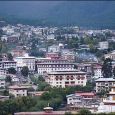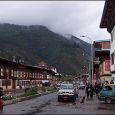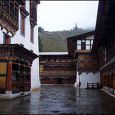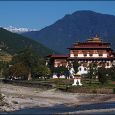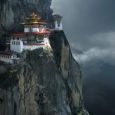Bhutan
Advertisement
Situated between India and Tibet, Bhutan is a landlocked country with limited access points. That brings to mind the question of how to reach Bhutan in the shortest, fastest way and what the available options are. The Kingdom of Bhutan is spread across the eastern Himalayas, and the popular way to travel in the country is via the winding mountain roads. However, there is more there is more than way to reach Bhutan. You could fly to Bhutan or travel to Bhutan by road.
How to Reach Bhutan by Air:
Paro is the international airport of Bhutan. Regular flights operate between Paro and Delhi and Kolkata. If you are traveling to Bhutan from Nepal, you can avail of direct flights to Paro from Kathmandu, the capital of Nepal. All flights to Bhutan are operated by Druk Air, which is the national carrier of Bhutan.
Paro is a scenic valley-town of gurgling streams, quaint houses and old monasteries, hemmed in by the Himalayas. It is just a 2-hour drive from Thimpu. Car rentals and government bus services are available for the journey from Paro to Thimpu.
How to Reach Bhutan by Road
There is no rail network within the country and travelers can gain access to Bhutan by means of road transport – buses, private cars, which are authorized by the government of Bhutan. All parts of Bhutan are well-connected by a network of roads. If you are planning to reach Bhutan from India, the point of entry is the border town of Jaigaon. It is about 150 kms from Siliguri, the furthest that you can get near Bhutan by rail. A stately gate separates the Indian town of Jaigaon from the Bhutanese town of Phunsoling. Cars are available for hire from Siliguri to Jaigaon. You can book the very same car to take you to Bhutan or on reaching Jaigaon, get in touch with local tour operators to book a car for your tour to Bhutan and back.
The laws for traveling to Bhutan are stricter for people of other nationalities than of India and China. The purpose of such laws is to preserve its environment and culture. Both the touring party and the car rental company need to acquire permits to be in Bhutan for a given length of time
Get to know more about the How to Reach Bhutan on the site touristplacesinindia.com and also find useful inputs about Bhutan.
Advertisement
TOURISM IN BHUTAN - HISTORY
Because of its unique geography, in the past getting to Bhutan was practically impossible for Europeans. The first roads in the country weren’t built until the 1960s, and only a handful of adventurers made it to the central valleys before 1974, when the first hotels were built to accommodate dignitaries arriving for the coronation ceremony of the current King.
These original hotels, The Olathang in Paro and The Motithang in Thimphu, were carefully placed well outside of town to prevent unnecessary interaction between foreigners and locals. After the coronation, the government began to welcome a trickle of tourists, barely enough to keep the two hotels in business. In 1979, a total of 250 tourist visas were issued.
At this point, the government recognized the potential benefits of tourism as a source of hard currency and good public relations. However, officials were also wary of the state of affairs in nearby Nepal, which opened its borders to mass tourism back in the ‘60s and became a popular stop on the famous Hippy Trail. Bhutan, officials vowed, would never have a Freak Street like the one in Katmandu, where long-haired Westerners smoked hash all day long and spent only $2 a day.
photo: Liz Burns
Tourism has therefore always been tightly controlled. At first the government ran the entire business itself, but eventually private companies were allowed to operate. These companies are all obliged to charge the same daily fee of $200. For a while, a separate category existed for trekkers, who were charged $150 per day, but this is no longer the case. At the moment, it’s $200 regardless of whether you stay in a leaky tent, a local guesthouse, or a comfortable hotel.
There are a few luxury Aman hotels in Bhutan exempt from the $200 limit that charge around $1000 per night. Ask your personal assistant for details.
In 2008, the current King will step down in favor of his son, the Crown Prince. A lot of things will change, including the tourism regulations. The word now is that the $200 inclusive fee will be done away with in favor of a flat $100 government tax per tourist, per day, with all other expenses dictated by the market. Bhutan will remain an exclusive destination.
TOURISM IN BHUTAN – PRACTICAL INFORMATION
All visitors must use a registered tour company. Many Western outfitters run tours to Bhutan, in partnership with local agencies, but it's possible to cut out the middle man and book directly with a Bhutanese operator. If you choose this option, it makes sense to deal with one of the larger and more experienced Bhutanese companies, which offer more flexibility. If an early snow storm closes the pass or wipes out your 4-day trek, it really helps if your tour company happens to own your hotel. Otherwise, you might get stuck pitching tents in a cow pasture – at $200 a night.
photo: Tim Patterson
Most people visit Bhutan with a group tour. Those offered by Western companies generally include around 15 people. If you organize your own trip through a local agency, it’s possible to travel in a small group or even as a couple, although a surcharge may be added to the daily fee. It’s impossible to register as a single traveler.
One leg of your trip must be by plane, with the national airline, Druk Air. Paro is the only airport. Druk Air flies to Bangkok, Calcutta, New Delhi and Kathmandu, but will soon debut flights from Singapore and several Indian cities. Round-trip airfare to Bangkok is around $760 dollars.
The flight to Bhutan is one of the most dramatic in the world. Most likely jet-lagged into a daze, you’re suddenly jolted awake by adrenaline as you pass by the peak of Mt. Everest. The plane drops into a narrow valley for the approach, banking around bends and over ridges like something out of Star Wars, before touching down amidst rice fields and ancient farmhouses. The flight from Kathmandu has the best mountain views of any commercially scheduled flight in the world. Get a window seat.
Entering the country overland at Puenthsoling is an interesting option, because the 6-hour drive up the river valley gives you the experience of climbing through various eco-zones to the heart of the Himalayas. Visas are issued at this border as well as at the airport, but to get a visa you must be pre-registered with a tour. The cost is $20. Keep your ear to the ground regarding regulations at the new overland crossing between Southeastern Bhutan and Assam, which is exit-only for the time being.
The government mandated $200 daily fee must include everything except souvenirs and drinks, so you don’t need to worry about constantly bargaining. The Bhutanese currency, the ngultrum, is pegged to the Indian rupee, at an exchange of about 44 ng to $1. Rupees are also widely accepted. A bottle of water costs around 15 ng in town and 35 ng in hotels. A ten minute taxi ride in Thimphu is around 60 ng. Bhutan produces excellent rums, and you can buy a liter of Dragon Rum for around 100 ng in shops, more in hotels. Tastes great mixed with mango juice.
Souvenirs are rather expensive, both because the Bhutanese are used to dealing with wealthy tourists and because the quality of local crafts is excellent. Bhutan produces some beautiful textiles, lots of Buddhist art and interesting metalwork. The Thimphu market (Fri-Sun) is a good place to shop. Be careful with antiques, because like anywhere else in the world, some are made to order. If you find something that really does look medieval, remember that it is illegal to bring any object over 100 years old out of the country. Save receipts.
photo: Tim Patterson
You can change travelers checks and foreign currency at the airport, major hotels, and banks in Thimphu. Visa cards are usually accepted in stores that cater to tourists, but not elsewhere.
International calls are possible but expensive at most hotels, but the local mobile phone network within Bhutan is extensive. Slow internet access is available in Thimphu at around 70 ng per hour and you can also get online at a few of the larger provincial hotels, where it’s more expensive.
Electricity is 220 volts, and the plugs are large and three pronged. Bring an adaptor.
The biggest travel company in Bhutan is BHUTAN TOURISM CORPORATION LIMITED, owned in large part by the royal family. This is the company that organized our tour and I was extremely impressed by our guide, driver and the BTCL hotels. Their website is www.kingdomofbhutan.com.
The second biggest tour operator is called ETHO METHO, online at www.ethometho.com. You might also take a look at www.lingkor.com, the website of a tour company owned by a reincarnate Buddhist holy man turned entrepreneur who seems to remember partying with my Mom in New York City in the 1970s.
It’s quite easy to arrange individually tailored trips geared around a specific theme, such as birding, rafting, trekking or Buddhist studies.
CULTURE
Bhutan is the last of the independent Himalayan Buddhist kingdoms. Religion is very much a part of everyday life, which centers around farming and family. Most Bhutanese still live a long walk from the road in big, beautiful farmhouses with terraced rice fields out front, red chili peppers drying on the roof, and white prayer flags snapping in the breeze. The outside walls of these farmhouses are often decorated with religious iconography. Very large, realistic illustrations of erect penises are especially popular decorations, a practice believed to date back thousands of years to pre-Buddhist creeds that did not discriminate between spiritual and physical vitality.
photo: Tim Patterson
Because travel within Bhutan is so difficult, over the years each valley developed its own unique culture and distinct dialect. Over a dozen languages are spoken within the kingdom. The national language is called Dzongkha, as it is the language of the ancient fortress-monasteries, or Dzongs, which still function as the governing center of each province. Dzongkha is taught in schools, but the basic language of instruction is English, so nearly all young people are at least tri-lingual, speaking Dzongkha, English and the local language of their valley.
The most prominent minority group in Bhutan consists of Nepali and Indian laborers, most of whom are officially classified as guest workers. They do roadwork and construction, jobs most Bhutanese are unwilling or unable to take. Many of these economic migrants settled in Southern Bhutan over the years, until the government grew concerned that they were beginning to outnumber native Bhutanese, and forced many to leave the country. This was a controversial move, especially because Nepal refused to accept most of the migrants, who relocated to makeshift camps. This problem contributes to the King’s determination to promote cultural unity, to the point of enforcing a national dress code and emphasizing Bhutanese values in the school curriculum.
Despite the vitality of traditional village life, some elements of Western culture have made inroads in Bhutan, but most are given a distinctly Himalayan twist. Television was made legal in 1999, and with the government making a big push to bring electricity to the provinces, most Bhutanese now have access to American sitcoms and Indian soap operas. A high reincarnate lama assured me that Thimphu boasts several good discos, and when I went downtown to find them, I noticed a movie theatre with a huge crowd out front, everyone lined up to see Norbu, My Beloved Yak. Two great Bhutanese flicks available outside the country are The Cup and Travelers and Magicians, both directed by Khyentse Norbu (no relation to the Yak).
photo: Liz Burns
Archery is Bhutan’s national sport and if you see a match in progress be sure to stop and watch. Two teams face off at opposite ends of a range that stretches for all of 140 meters, with a tiny target barely visible at the far end. The opposing team stands around the target, trying to distract the tiny figure off in the distance who is launching deadly weapons in their direction. The archer lets fly, and if it’s a hit, everyone does a dance and sings and drinks rice whiskey before the next round. Somehow, its rare for people to take an arrow to the face, even when they are leaning over the target and yelling rude things down-field about the archer’s sister.
The Tantric Buddhism practiced in Bhutan includes a vast pantheon of demons, bodhisattvas and other deities. Practitioners believe in the karmic cycle of reincarnation and strive to accumulate merit through good deeds and the performance of rituals. Good people achieve good rebirths. The ultimate goal is to accumulate enough positive karma to escape the cycle of birth and death entirely. It’s common to see elderly men and women walking down the street muttering mantras and turning prayer wheels, which are conveniently built into walls along the sidewalks in towns. Stringing up prayer flags over rivers or on ridgelines is another way to accumulate good karma. The prayers written on the flags are absorbed by the wind and water, which carry their sacred messages to all creatures of the world. Some massive prayer wheels are placed over streams and constantly turned by the flow of water. Feel free to give prayer wheels a spin, but make sure you do so clockwise. Get it wrong and you might come back as a cockroach.
Photo: Liz Burns
The importance of good deeds includes a deep respect for all forms of life, from the smallest ant to the earth herself. During my travels, I sometimes saw Bhutanese stop on the sidewalk, pick up insects, and move them out of harms way. Fishing and logging are heavily regulated and frowned upon, as is the killing of animals for meat, although most Bhutanese happily eat pork and beef that someone else has slaughtered.
Many Bhutanese become monks at a young age. It can be a stark life of chanting and mediation for these boys, especially in monasteries perched high in the mountains, but there is an otherworldly sense of purity and peace in such places.
Respect and devotion to the King is prevalent among Bhutanese, and in my opinion very much deserved. Since taking the throne at the age of 17, H.M. Jigme Singye Wangchuk has worked to protect Bhutan’s cultural heritage while promoting certain forms of development. He has made a priority of environmental protection, cultivated diplomatic ties, and most remarkably, gradually eased himself out of the role of absolute monarch by transferring administrative power to a legislature. In 2005 a constitution was drafted and is now in the process of being approved for ratification by democratic vote.
The King is such an interesting figure that it’s worth devoting a few words to his private life. Instead of ruling from the palace, he chooses to live in a small bungalow hidden among pines in the hills overlooking the capital. He drives a Toyota Land Cruiser with a license plate that simply reads, “ BHUTAN”. The King’s four wives, all sisters, and all beautiful, each have their own mansion in the town below. Their license plates read “ BHUTAN 4”, “ BHUTAN 5”, “ BHUTAN 6,” and BHUTAN 7”. The Head Abbot has “ BHUTAN 2” and the Crown Prince drives “ BHUTAN 3”.
photo: Liz Burns
The King’s hatred of corruption is legendary. A few years ago, a decision was made to move the provincial capital of Punakha to a site downstream that would be less prone to flooding. The father of the King’s four wives quietly bought up farmland in the area where the new town would be built, thinking that it would soon appreciate in value. When the King found out, he was furious. Not only did he make sure the land went back to the farmers, he let them keep the money his father-in-law had paid. Incorruptible, modest and wise leadership…as an American, I can only dream.
PLACES
The four valleys I visited in Bhutan are, from West to East, Paro, Thimphu, Punakha and Phobjika. In this section I’ll give a quick rundown of the attractions you’re likely to experience in each of these destinations and also point you towards some less well known spots that I recommend.
Paro
All visitors to Bhutan will be in Paro Valley at some point to use the airport. Despite the runway, which is almost as wide as the valley floor itself, the area has retained a rural character and charm. Large, elaborately decorated farmhouses are scattered among fields of Bhutanese red rice, overlooked by one of the most beautiful and historically important Dzongs in the country. Our group stayed in the Olathang Hotel, the same hotel that was built for the King’s coronation. The best rooms are the bungalows, set in a pine grove with views up and down the valley.
Paro town is basically two streets running parallel to each other North of the airport. There are several local craft shops and a nice art gallery with original Bhutanese paintings and a terrific selection of black and white photographs.
The National Museum is in the old circular watchtower on a ridge above the Dzong. There are hundreds of beautiful Buddhist statues on the top floors and a dungeon downstairs where the first king of Bhutan was briefly incarcerated. There is also a display of medieval weaponry, but the doorway is heavily signposted with Buddhist texts preaching the virtues of pacifism.
There are several temples in Paro, including Kyichu Lhakhang, which dates back to the 7th century, when Buddhism first arrived in Bhutan. Your tour guide should be able to arrange a visit to Kyichu, which is located along the Paro River a short drive upstream from the center of town. With luck, the monks will allow you to view the original statues of the inner sanctum, long since dyed black by a millennium of smoke from butter lamps.
No visit to Bhutan is complete without a trip to the famous Taktshang Monastery, or “Tiger’s Nest,” which hangs from a sheer cliff thousands of feet above the valley floor, about 10 kilometers North of Paro town. Taktshang is actually a group of several monasteries, but Tiger’s Nest is by far the most dramatic. The founder of Buddhism in Bhutan, a man named Guru Rinpoche, arrived at Tiger’s Nest from modern day Pakistan on the back of a flying tiger. He and several other important Buddhist figures are said to have meditated on this cliff, living as hermits in a cave that is now the sacred core of the monastic complex. The physical landscape alone is staggering, but Tiger’s Nest is one of those rare places where human works have only added to the raw magnificence of nature, creating a transcendent beauty that vibrates in one’s soul.
At a leisurely pace, it takes about an hour to walk up the trail to a restaurant, where you can stop for a cup of tea and admire the view of the monastery perched on the cliff opposite. The trail is not so difficult, but those who wish can ride ponies as far as the restaurant by giving their guide advance notice the night before. From the tea house, the trail gets steeper, winding up to a viewpoint above Tiger’s Nest. If you’re scared of heights, this is as far as its wise to go, but most people will have no trouble with the final bit of cliff-hugging path to the monastery itself. Railings have recently been added to the hairiest section, but remember the cliff when backing up to get a good angle for a photo; a Japanese woman once failed to do so and fell into the upper branches of an oak tree. It took several hours before the Indian Army helicopter could be summoned to rescue her.
Two lesser known destinations in Paro that I enjoyed visiting are Dungste Lhakhang temple and Dzong Drakha monastery. Dungste Lhakhang is located on the East side of the river upstream from the National Museum. When I visited, a funeral rite was in progress, and it was haunting to hear the monks chanting and beating drums as I climbed up worn wooden ladders to the upper levels of the temple. The wall paintings inside are breath-taking, but it’s very dark, so bring a flashlight.
Dzong Drakha is located a few kilometers up the road that leads West over Cheli La pass to the Haa Valley. This road has only been open to tourists for 3 years, so very few visitors know about the monastery. It’s sort of a Tiger’s Nest junior, perched on a less dramatic cliff about 40 minutes walk from the road. The views are magnificent, and you’re unlikely to run into other travelers.
At the far Northern end of the valley, where the road ends, you’ll find the ruins of Drukyel Dzong, built to guard against invaders from Tibet. It’s best to come up here on a clear day for terrific views of Mount Jomolhari looming at the head of the valley.
Thimphu
The capital city of Thimphu is a dusty 2-hour drive from Paro. The road is due for widening and repair by next year, but this project has a long way to go. A growing population of around 70,000 people make their homes on the surrounding hills, making Thimphu the closest thing to a city you’ll find in Bhutan. Traffic can be thick along the main street, but there are still no traffic lights, just a white-gloved policeman directing cars at the central interchange.
It’s easy enough to navigate through town on foot, and you’ll have no trouble getting your bearings because everything slopes down to the river. Downtown is bustling, and several new tourist facilities are being built, including a massive structure that will soon be a luxury Taj hotel.
The residential neighborhoods are mainly on the hillside to the West of town. I stayed in one of these quiet suburbs at the Motithang Hotel, which was quirky and pleasant. A stuffed sun bear holding a drink tray stood in the hall outside my room, giving me a reliable pre-coffee jump in the morning. Those interested in wildlife can visit an enclosure just up the hill from the Motithang where the King keeps a herd of Takin, the national animal of Bhutan, which looks like the outcome of a cruel experiment involving a moose, a goat and a wildebeest.
Most practical things a visitor might need to buy are available in the shops downtown. Those hungry for a taste of home can check out the iconic Swiss Bakery just up the hill from the traffic circle. The weekend market is a great place to snap colorful photos and pick up souvenirs.
The government offices are located at the North end of town in an impressive Dzong. When our group arrived the royal fleet of Land Cruisers was parked by the front gate. There is also a golf course up this way. If anyone is interested in hitting the links and schmoozing with Thimphu’s upper crust, the greens fee is $25.
The drive up Thimphu valley makes a great day trip for those who want to get out of the city. Not many travelers take this road, which goes through villages, past the royal palace (where the King’s mother now lives) and by the training ground of the Royal Bodyguard, which looks suspiciously like a pitch and putt golf course. The road ends in a forest at the base of some steep foothills, with two monasteries hanging from the heights on either side. It’s possible to visit either Cheri or Tango monastery, both about 45 minutes by hiking path from the road.
Punakha
Punakha is only about 40 kilometers from Thimphu as the crow flies, but the drive can easily take the better part of a day with a lunch break and a few photo stops. Be sure to bring your passport, because there is a checkpoint one hour outside Thimphu where soldiers can ask to see identification.
The road climbs up to Dochu La pass, an important spiritual place for the Bhutanese. Definitely make time to get out of the bus, stroll through the forest of prayer flags and take in stunning views of the Himalayan range. There is a restaurant a few hundred yards beyond the pass which is a perfect place for lunch. It’s also possible to stay here for a night and wake up early to catch sunrise over the snow peaks.
Punakha valley is much lower than Thimphu, so once over the pass, the road goes down and down through thick green virgin forest. Keep an eye out for monkeys, red pandas, rare birds and beautiful tree lilies. The valley itself is carved by two wide glacial rivers that come together below Punakha Dzong, which many agree is the most beautiful fortress in all of Bhutan. Traditionally, the monks from the Dzong in Thimphu spend the winter at Punakha, taking advantage of the relatively mild climate.
I stayed for four nights in Punakha at Hotel Zangtho Pelri. Again, the bungalows are the best rooms, although the water tank in ours exploded at 1 o clock in the morning. Besides the Dzong, I highly recommend a day trip up the valley to the vast Jigme Dorji National Park. The road follows a roaring river through farmland, where you can get out and walk up to hillside villages. The National Park itself is a great place for spotting rare mammals and birds. It’s possible to drive all the way up to the border of Gasa Province and still be back at the hotel in time for dinner.
Phobjika
I visited Phobjika as a day trip from Punakha, but would definitely recommend staying there for one or two nights. The valley is well known as the winter home of Black-Necked Cranes, which arrive in mid-October after flying over the Himalayas from Tibet. The cranes are sacred in Bhutan, and the government has gone to great lengths to protect their habitat. All electrical wires in the valley are buried and carpenters must follow strict codes when building new structures. All of Bhutan is an oasis of tranquility, but thanks to the cranes, Phobjika stands out as an especially enchanting landscape.
In past years, the only way to get to Phobjika was on foot, but a road has been built that branches off the main West-East high way just before the pass into Central Bhutan. It takes about 3 hours to make the trip from Punakha. There is a large temple on a hill overlooking the valley which is currently undergoing extensive renovations. The Hotel Dewachen in Phobjika served the best meal I ate in Bhutan, which, unfortunately, isn’t saying a whole lot.
FOOD
Most meals in the hotels are served buffet style. At dinner, the first course is soup, which the wait-staff will bring to your table. A big pot of rice is standard, usually accompanied by dishes that include pork or beef, a curry of some sort, steamed vegetables and baked or fried fish (watch out for bones), At the end of the line, there will often be a bowl full of Bhutan’s national dish, ema-datsi, or hot chili peppers in cheese sauce. Wickedly spicy!
It’s a stretch to call breakfast Western style, but the cooks do try, and at worst you can always fill up on toast. Lunch is much like dinner, but without the soup.
The food isn’t bad, but it does get monotonous. It’s a good idea to bring some granola bars or trail mix from home for day hikes or long bus rides. Brave diners can try ready made market food, but be careful with chogo, dried cubes of yak cheese hard enough to break teeth.
TREKKING
Sadly, I wasn’t able to go trekking, but I talked with some trekking guides and can give general advice. The most important thing to understand is that when you go up into the mountains, you do so on the mountain’s terms. If the weather turns bad, or the altitude starts to get to you, or the guide has forgotten his mittens, it doesn’t matter how much you paid or how carefully you planned, you have to turn back! Over-confident trekkers have died in Bhutan. Make sure to go with a reputable agency and prepare yourself mentally and physically for adversity. That said, I wish I could have done a trek.
USEFUL PHRASES
I couldn’t find much in the way of Bhutanese phrasebooks on the web, so its quite possible that the following is the best resource available! Very, very few foreigners manage to learn more than a couple words of Dzongkha, and any effort will be sincerely appreciated. You might even get local prices at the hotel bar, especially if you are as handsome and charming as me. I’ve spelled the Dzongkha words as they sound to my ear, no guarantee of accuracy.
Information not available
Information not available
Advertisement

